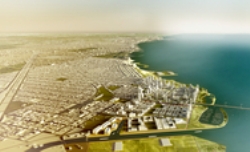Aug 14 2013
Rapid urbanization around the world is leading to the construction of real estate developments at a scale and pace far beyond human experience. Among these efforts is Chicago Lakeside Development, a 600-acre development on the coast of Lake Michigan on the city's South Side that will eventually be home to 50,000 people and millions of square feet of retail, commercial and public space.
 An artist's rendering of the planned Chicago Lakeside Development, a 600-acre development on the coast of Lake Michigan on the city's South Side that will eventually be home to 50,000 people and millions of square feet of retail, commercial and public space. Image courtesy of Chicago Lakeside Development/McCaffery Interests.
An artist's rendering of the planned Chicago Lakeside Development, a 600-acre development on the coast of Lake Michigan on the city's South Side that will eventually be home to 50,000 people and millions of square feet of retail, commercial and public space. Image courtesy of Chicago Lakeside Development/McCaffery Interests.
Planning for Chicago Lakeside will necessitate augmenting traditional tools with data and scientific computation, allowing developers to model the complex interplay between energy, waste and water infrastructures. To address this need, a collaboration between the University of Chicago, Argonne National Laboratory, the Computation Institute, Skidmore, Owings & Merrill and McCaffery Interests will develop a prototype computational framework for Chicago Lakeside Development, called LakeSim.
"Urban designers, architects, and developers have ample experience and tools optimized for single buildings or developments in the 20 to 30 acre range. But these do not scale to the 600 acres of a site such as Chicago Lakeside," said Charlie Catlett, director of the Urban Center for Computation and Data and co-investigator on the LakeSim project. "The need to deliver sustainable and financially viable urban plans requires a science-based approach, bringing the power of computational models to city design."
LakeSim will connect existing urban design tools with scientific computer models to create detailed simulations relevant to large-scale development. Instead of planning separately for different pieces of the infrastructure, the framework will allow developers to simulate how various designs influence the environment, transportation, and business spheres in Chicago Lakeside under a range of possible scenarios, over hundreds of acres and decades of time.
"As it stands right now, urban development is often looked at as individual components that make up a whole," said Leah Guzowski, energy policy scientist at Argonne and LakeSim co-investigator. "But when you get to a site the size of Lakeside, the interdependencies of the various components are less understood, and the consequences of decision-making are much more significant. We are focused on developing more efficient and effective ways of making decisions informed by science."
LakeSim will also allow planners and developers to explore a wider range of designs more quickly, without the lengthy periods of re-analysis currently required for each aspect of the development when a new strategy is proposed. An urban planner would make changes to their plan – for example, changing a residential block to commercial – triggering the execution of computational models that rapidly predict the effects of those adjustments across multiple complex systems, such as energy supply or storm water management.
Ed Woodbury, president of McCaffery Interests, said that the tool fits the real estate developer's vision of Chicago Lakeside as a "living laboratory" for urban development.
"Lakeside is a great chance for Chicago to reset the paradigm for infrastructure and real estate development," Woodbury said. "The scale of the site gives us almost limitless variables and limitless opportunities to see the effect of different strategies for implementing the development as we move forward. LakeSim will allow us to quickly model different development scenarios and intelligently implement the next generation infrastructure we have envisioned."
Beyond Chicago Lakeside, the researchers hope that the LakeSim framework will be useful for other large-scale developments elsewhere in the United States and around the globe. In rapidly urbanizing countries such as China and India, where hundreds of millions of people are expected to move into cities over the next decade, such tools will be essential to design urban areas that are livable, efficient and environmentally sustainable.
"With the Lakeside site, we're thrilled to be applying our scientific and technical capabilities on a project that will impact Chicago and the greater region," Guzowski said. "On a broader level, better and deeper knowledge of how cities are planned and operated will have tremendous economic and environmental implications given the rise of global urbanism and the pace at which it is occurring."
Source: http://www.anl.gov/